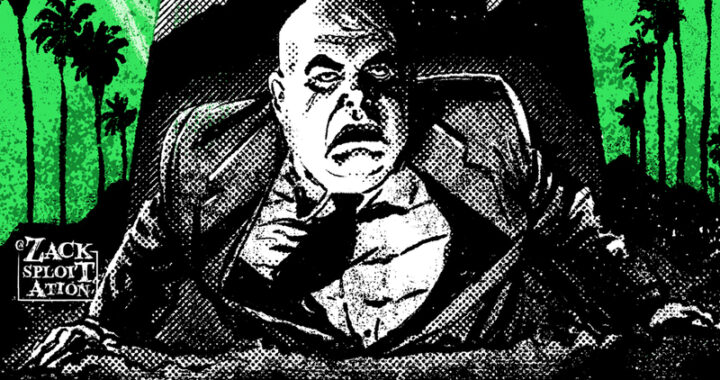
“Child of Light and Darkness”: A Retrospective of Claremont’s X-Men, Part 5
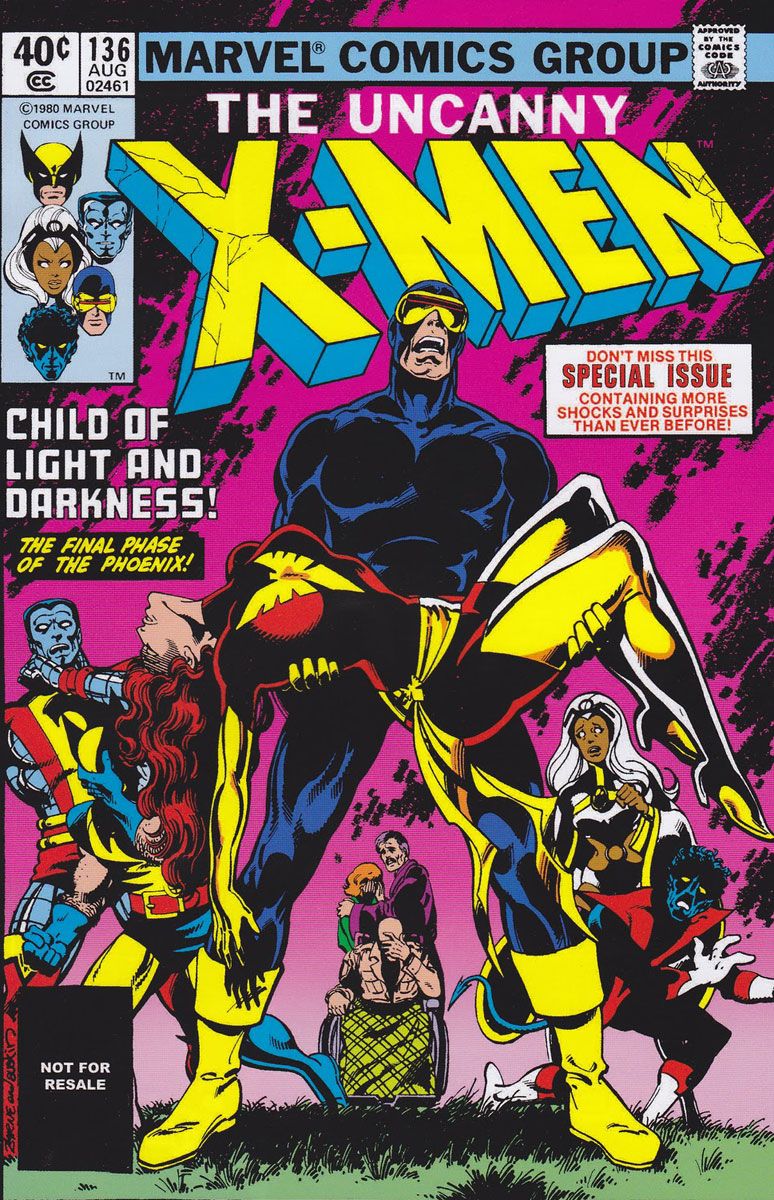 By the time they began work on the Dark Phoenix Saga, Chris Claremont and John Byrne had truly hit their creative peak on Uncanny X-Men. It was a golden period that had its early rocky patches, but despite their differences, they had become the iconic creative team that defined the X-Men. They may not have necessarily have been aware of it at the time, since they were caught up in the process, but by the end of this story, they became a well-oiled machine that was turning out classics almost every issue.
By the time they began work on the Dark Phoenix Saga, Chris Claremont and John Byrne had truly hit their creative peak on Uncanny X-Men. It was a golden period that had its early rocky patches, but despite their differences, they had become the iconic creative team that defined the X-Men. They may not have necessarily have been aware of it at the time, since they were caught up in the process, but by the end of this story, they became a well-oiled machine that was turning out classics almost every issue.
In addition, there was a strong cast of supporting players around them that shouldn“t go overlooked. Terry Austin deserves credit for being one of the most talented people ever to ink over Byrne, and he was a strong presence throughout these years on the book. Tom Orzechowski is a veteran letterer who defined the lettering style of the book through most of Claremont“s tenure, and he“s currently active in the industry today (most recently in The Green Lantern). Glynis Wein (later credited as Glynis Oliver) is also another name that would follow Claremont through most of his X-Men run, and her coloring was always vibrant and impactful on the page. This group of people, but especially Orzechowski and Oliver, helped give the book a sense of visual consistency regardless of who drew the book, and it worked for over a decade.
However, it“s during the Dark Phoenix period that Uncanny X-Men first started showing some inconsistency on the editorial front. Up until this point, Roger Stern had been editor on the title, and he generally had good storytelling instincts, especially on team books. This would eventually lead to a highly successful run on Avengers, including some series-defining arcs on that title. Stern eventually bowed out of editing X-Men during the Dark Phoenix Saga, only to be briefly replaced by Jim Salicrup, a respected hand at the Marvel Bullpen. However, it was the arrival of Louise Jones””better known today as Louise Simonson””that led to a different era for the X-Men moving forward for several years.
It is this editorial shakeup that led to some well-regarded classics under Louise Simonson“s reign as editor, then followed up later by her successor, Ann Nocenti. However, the shakeup is also indirectly responsible for the controversial ending to the saga. In many ways, Dark Phoenix“s ending was a “happy accident”“ for the series, a resolution driven by events and necessity than a long-term plan. Dark Phoenix can be likened somewhat to Casablanca, which likewise hadn“t settled on an ending until the resolution finally came through an unforeseen process. Also, much like Casablanca, Dark Phoenix“s ending is based on a noble heroic sacrifice at the cost of love. The Dark Phoenix Saga is a nearly unique instance of all parts of the creative process””from writer to artist to editorial””pushing and pulling together to create a stronger whole.
For all that the ending was accidental, the actual setup to Dark Phoenix had been planned like clockwork. Chris Claremont had spent years building up the Hellfire Club, but up until this point, they“d never been properly identified as villains, mostly being cloaked in shadow. When they were referred to at all, they were referred to as “The Council of the Chosen”“. However, Sebastian Shaw“s Hellfire Club are the same people who had been working with Stephen Lang, who unwittingly led to Jean becoming Phoenix in the first place. They were also the ones who had sent a minor villain called Warhawk to attack the X-Mansion on a previous occasion. We“d also seen hints of Jason Wyngarde and his interactions with Jean Grey, leading her into brief “timeslip”“ spells into the past. Claremont and Byrne had spent many years between them in planting the seeds for Jean to lose control at the hands of the Hellfire Club, but it“s here that their ambitions would see results.
The first part of the Dark Phoenix Saga centers on the introduction of Kitty Pryde, who would go on to enjoy an unprecedented long character arc that stretched well past even Claremont“s era on the book. At the time she first appears, Kitty is a thirteen-year-old teen prodigy who suffers from constant headaches, not realizing that she“s manifesting her mutant powers for the first time. Claremont and Byrne cleverly set up her phasing powers by having her fall through the floor, not realizing what had happened to her.
Kitty is in many ways the perfect viewpoint character, and she was designed to be the “normal”“ lens for the reader. Where the other X-Men were more outlandish, like Nightcrawler or Wolverine, Kitty could keep the story grounded in an experience that the casual audience could connect to. She had qualities that made her extraordinary, such as her high intelligence, but she had human weaknesses that compensated for them. She had a “girl next door”“ appeal, but she was also naïve and inexperienced and prone to making “rookie”“ mistakes. In other words, Kitty was the X-Man that many readers might have thought they could be or wished to be. It“s the same appeal that worked for the more successful teen sidekicks, and when they were allowed to grow, so did Kitty. Moreover, Kitty had an interesting power set””her power was primarily defensive, and it reflects the fears of being able to touch or interact with the world in any meaningful way. She was the perfect new character at that time, and she tapped into the fears and concerns of her audience on a deep and primal level.
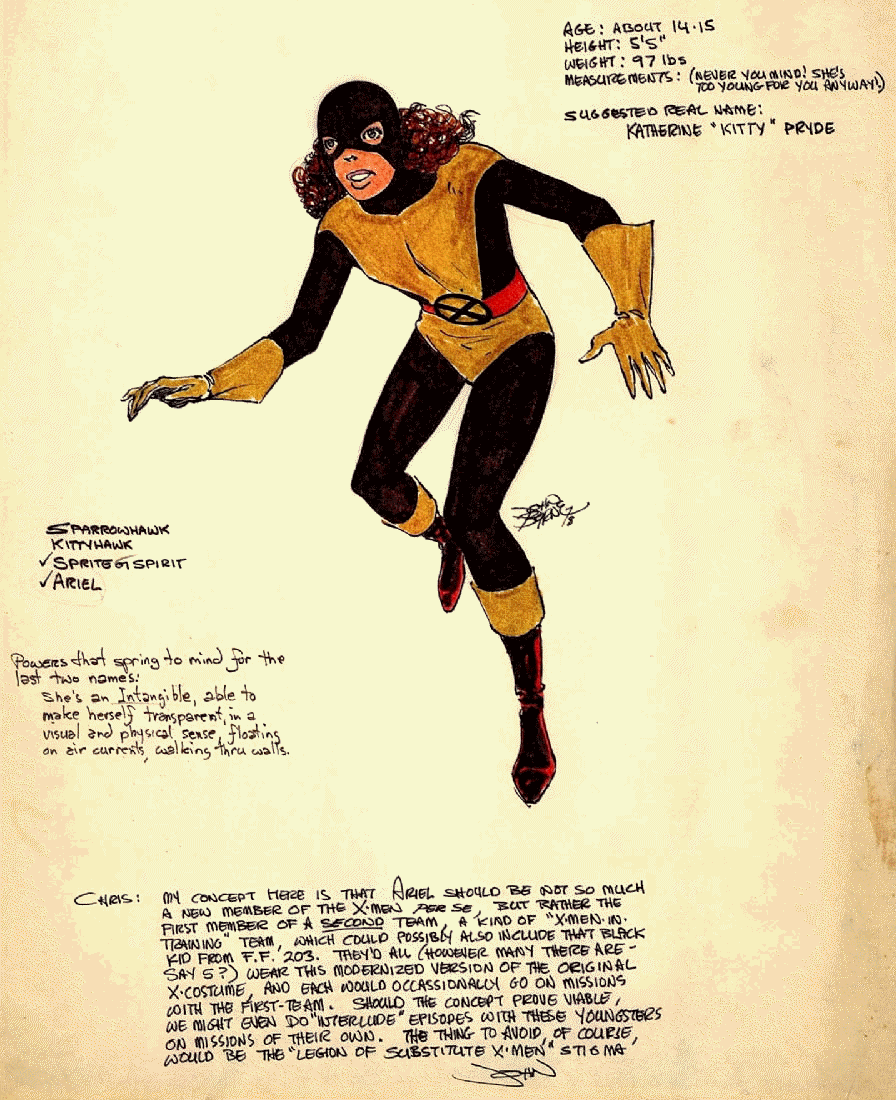
Once the X-Men become aware of her through Cerebro, Xavier wants to recruit him into the school. However, the Hellfire Club is already a step ahead of them, as Emma Frost has her own plans for recruiting Kitty into the White Queen“s own Massachusetts Academy. This is the first time that the idea of a rival school to Xavier“s was introduced, and it“s always been an idea with merit. In many ways, Emma starts off as a darker mirror to Xavier himself, an evil telepath who coldly manipulates others in the guise of a teacher. Early on, the White Queen was portrayed much more villainously, and in ways that might seem odd for modern X-readers who are used to seeing Emma as an anti-heroine. However, that portrayal leads to some of the strong rivalries Emma has in later years, especially with Kitty and Storm, her most persistent enemies. In any event, Emma is certainly one of Claremont“s most enduring creations, and for a time, she was among the team“s best villainesses throughout his run.
While the X-Men are enjoying an ice cream with Kitty, the White Queen sends a group of Hellfire Mandroids to attack the X-Men. This leads to the X-Men getting captured and Kitty sneaking aboard the Hellfire ship with her new powers. If there“s a slight mistake here, it“s that the story doesn“t make it clear how a powerful telepath like Emma wouldn“t notice Kitty“s thoughts, but it“s a barely noticeable concern in an otherwise exciting introduction story.
The following issue is the first appearance of Dazzler, but she wasn“t brought in quite as organically into the series as Kitty was. Dazzler is quite an interesting character in that she“s an entertainer who just happens to have mutant powers, rather than someone trying to be a superheroine. However, that comes from her creative origins. Dazzler was created by Marvel as a project for Casablanca Records, with the idea of making a feature film. However, plans fell through, as often happens, leading Marvel to debut Dazzler in Uncanny X-Men. She wouldn“t involve herself often with the X-Men for several years, where she“d return at the close of the Mutant Massacre. As far as Dark Phoenix is concerned, Alison is very much a side character in an issue that“s mainly about Jean and Scott, establishing the buildup towards the Dark Phoenix event.
For the most part, the issue just succeeds in moving the story where it needs to, continue hinting at Jean“s steady loss of control, and her temptation by Wyngarde. At this point, the readers do not yet know that Wyngarde is Mastermind, but Claremont and Byrne are quite clever in hinting at the presence of the team“s old enemy. Perhaps the cleverest method used throughout Dark Phoenix is Byrne“s use of shadow effects to reveal Mastermind“s real shape. It“s a subtle effect, but the disconnect between his shadowy true form and his illusory Wyngarde form makes a strong visual impact. It also is a point that Claremont references during the Hellfire Club battle, as Scott remembers seeing Mastermind“s shadow and uses it to finally unmask the villainous illusionist.
The initial arc culminates with Kitty reaching the X-Men, and the team confronting the White Queen and rescuing their captured friends. Mostly this brings the first phase of a story to a close, with Emma facing her first defeat against the X-Men and Jean once more tapping into the dark side of the Phoenix. Kitty also manages to get her first opportunity to prove herself with the X-Men, using her phasing power to help with the rescue mission while Phoenix confronts Emma. It“s a good first-act conclusion to Dark Phoenix, showing Jean a glimpse of how evil she might become with Emma, but also in showing her how far she might go to destroy a enemy if pushed far enough. So while it seems a solid enough resolution, It leaves Jean at the moral brink, and at just the right emotional place for Mastermind to strike.
From here, when talking about Dark Phoenix, it“s necessary to address the sexuality metaphors, and they are indeed persistent throughout Claremont“s work. There“s no question that the Hellfire Queen visual designs are meant to evoke specific fetishes, representing the darker side of sexuality. Emma wears her sexuality in a different way than Jean“s”¦ in her introduction story, she presents herself as very formal, very cold, very reserved in a full business suit. However, beneath that, Emma is much more in control of her own sexuality, using the repressed look as a mask she wears to lure others into her web. Emma has always been a character who has owned her womanhood and taken pride in her, using her feminine power for her own advantage. The White Queen design has always echoed that aspect of her character, showing Emma“s power and willingness to weaponize it for her own advantage.
In the case of Jean, it“s a natural extension of Claremont“s larger message, but taken to a much darker place than we saw in the Cockrum run. The Dark Phoenix Saga truly begins as a story of sexual awakening gone very wrong, as Jean loses herself in her own newfound joy and power. The story can be very easily read in that light. At the same time, the Phoenix also represents the power of the archetypal feminine, not simply in its sexual aspects, but in its creative one. In his introduction to the Uncanny X-Men Masterworks volume that features this story, Claremont wrote that “in my cosmology, the Phoenix represents the primal passion of creation: she“s the spark that ignites the Big Bang and also the final fire that consumes what“s left at the very End.”“ It makes sense to embody that kind of cosmic power as female, then, since it“s essentially the power that breathes life into the universe and everything within it. Claremont“s vision for the Phoenix can also describe an entire life cycle as life is born, grows, matures, and then dies only to be renewed again. In the case of Dark Phoenix, however, the full power of the archetypal feminine is awakened in a young woman who lacks the maturity and wisdom to control it, leading to disastrous consequences.
The trigger is pulled with the next issue, which takes the X-Men to the Angel“s hideaway in Colorado. After the first battle with the Hellfire Club, Scott is becoming concerned that the X-Mansion has been compromised, so the move is largely a way of planning without being spied on. In practice, this serves another purpose as well, since it gets Xavier out of the picture long enough for Jean“s fall into Dark Phoenix to take place. It“s Scott“s fear for the Professor that keeps Xavier away when he“s most needed, and the distance allows him not to interfere until it becomes necessary for him to return. It“s that same fear that keeps Xavier from helping the team at their most pivotal hour. Looking at it now, it“s an interesting role reversal, as it“s usually Xavier making decisions without consulting anyone, and Cyclops being resentful of not being involved in the decision. Changing that dynamic shows how much Scott has grown into his own as team leader, and how much he“s moved beyond needing Xavier as his surrogate father.
At the same time, the trip to Colorado gives us a final glimpse into Scott and Jean“s love as it should be. The scene allows for Jean to act as herself one last time, to be the loving girlfriend to Scott Summers that the audience knows her to be, even with the temptation she“s struggling against. At the same time, there“s an ominous feeling to the scene where Scott and Jean finally consummate their love on the Colorado butte. It“s a moment of awakening for Jean, but what should be a moment of joy for her is undermined by dread and a longing for something greater. The satisfaction leads to a greater craving within her, as represented by the primal force of the Phoenix. It“s an excellent scene by Claremont and Byrne, giving a touching emotional moment while also hinting at the greater battle to come for both of them.
Scott leaves Xavier with Angel, while he takes the X-Men to investigate the Hellfire Club“s New York branch directly. However, this leads them into a trap, and the Hellfire Club is ready for them. The X-Men lose quite badly during this first encounter, and it“s an excellent example of how to establish a villainous threat. Claremont spent years in slowly setting the foundation and most of the main players, but here we see the Inner Circle in its full glory. Harry Leland, with the power to increase mass, who gets an initial victory against Logan by dropping him into the sewer. Donald Pierce, the mutant-hating cyborg who would eventually become a major enemy of Wolverine. Most of all, we see Sebastian Shaw, one of Claremont“s finest villains during his entire seventeen-year-run.
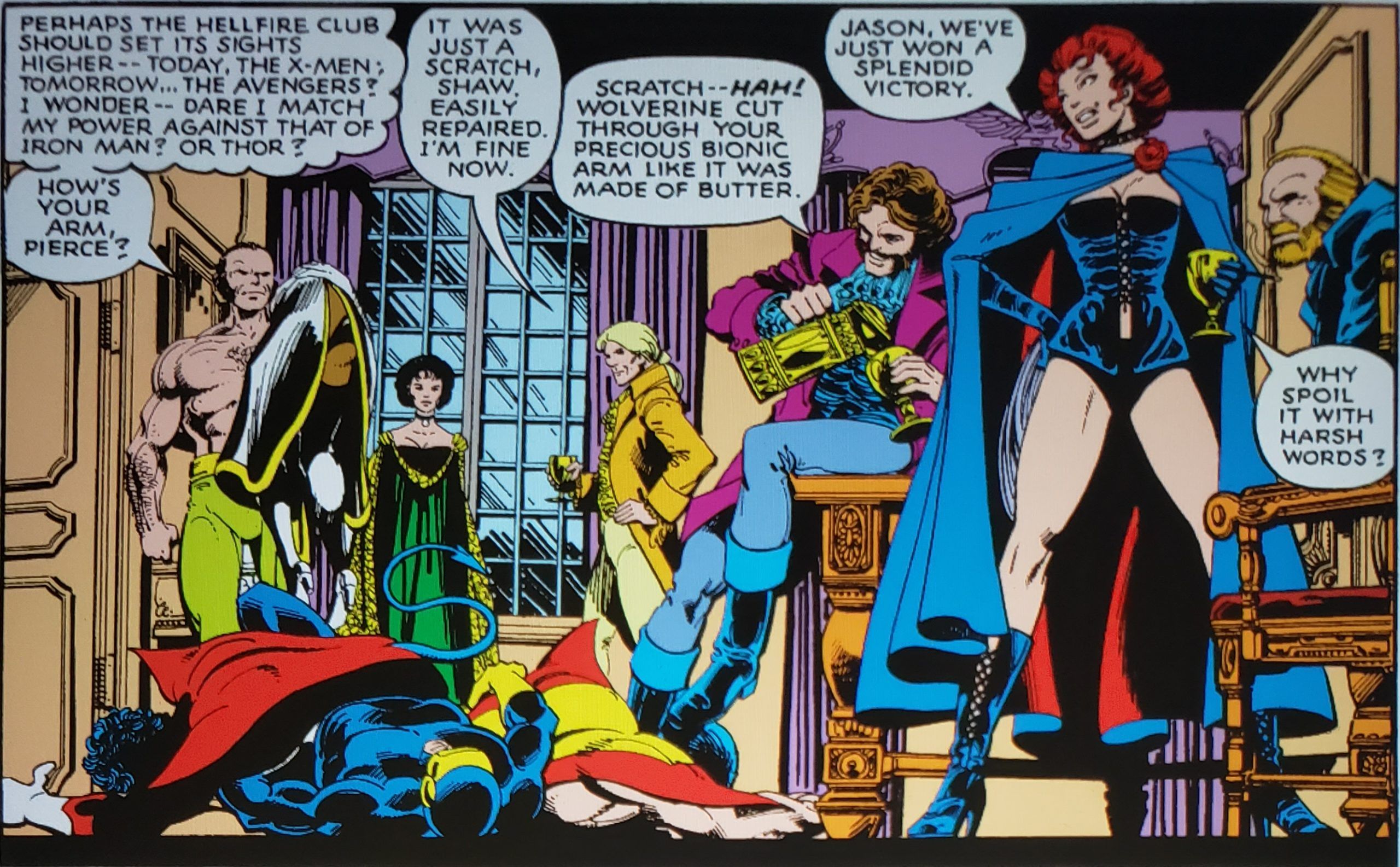
Although Shaw is not as highly regarded as an X-villain in later years, at this time he was among the X-Men“s most dangerous enemies. By this time, he had already been established as an effective schemer who could threaten the team from the shadows. Now, standing in the light, Shaw engineered one of the X-Men“s most bitter defeats, even defeating some of them in direct combat. Because Shaw has the power to turn kinetic energy into strength, he“s a powerful physical threat capable of defeating Colossus. All of this is combined with ruthlessness, cold opportunism, and his own vision, the idea of profiting off of his own kind to his own benefit. The revelation that Shaw wants to make money from other members of his own kind hits a level of bone-chilling evil that puts the Hellfire Club among the very worst. At the same time, they are powerful, wealthy, intelligent, and effective, all qualities that make for a powerful new villainous enemy.
Here, Mastermind and the Hellfire Club spring the final trap, using a mindtap mechanism to reach into Jean“s mind and corrupt her. At this point, she is not Dark Phoenix yet, but the Black Queen persona formed from the illusory “timeslips”“ into Jean“s past. This awakens Jean to the darker side of sexuality as represented by the Hellfire Club and their debauched value system. Claremont makes a point to show that Jean is using her femininity to influence the Inner Circle members as well, as if reinforcing the metaphor through the Black Queen“s interactions. However, Jean is a victim of mind control, and one could interpret this to represent an innocent torn away from those she loves and corrupted by the influence of evil men. Nostalgia for a romanticized past is used to lure her in, and her inhibitions are gradually torn away until she becomes someone else entirely. It“s a line of thinking that can lead to some truly dark places, but all of them consistent with the historical Hellfire Club that Claremont based his villains on.
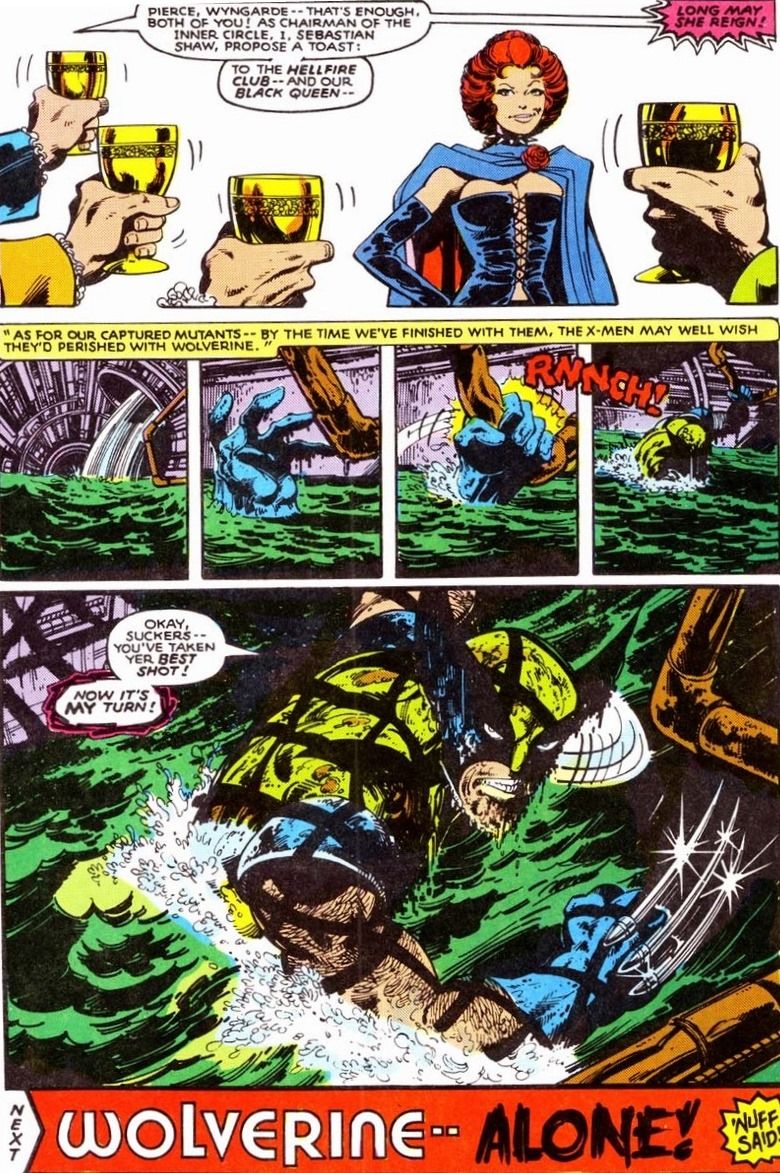
It goes without saying that some of John Byrne“s finest work as an X-artist can be found at the end of this issue. Logan was always Byrne“s favorite when he worked on the X-Men, and that“s very apparent with Logan as the escaped X-Man. Wolverine rising up from the sewers, claws extended, is an iconic image that“s remained with the character for years, and it“s for good reason. It“s visually striking, hits the core of who Logan is, and establishes him as the avenging anti-hero who is going to save his friends the next issue. It“s the right moment to leave the cliffhanger, and a great comic always leaves a strong final image that can stick in the reader“s mind.
The resolution to the Hellfire Club comes with a death and a sacrifice, which is interesting considering how the Dark Phoenix Saga concludes. It wasn“t an intentional parallel, but it is an interesting one. When all else fails, the only option to reach Jean comes from Scott. Here, Claremont and Byrne first introduce the telepathic rapport between Scott and Jean, a concept that comes back later in the series. With no other way of reaching Jean“s true self, Scott“s only option is to use the rapport to enter Jean“s mind and face Mastermind directly. This leads to a battle where Mastermind not only wins, but appears to kill Scott. The shock of this moment is what sends Jean back to her proper self, but it“s also the moment that creates Dark Phoenix in her full, terrible glory.
Wolverine returns to save the X-Men, and Jean uses the distraction to free the X-Men. This leads to a rematch where the X-Men defeat the Hellfire Club and they“re able to make their escape Unfortunately, it“s far too late to save Mastermind, and quite possibly too late to pull Jean back from the brink. Mastermind is a truly loathsome villain in this story, and he deserves every ounce of punishment he“s given, but even then”¦ what Dark Phoenix does to him almost inspires sympathy. She destroys the mindtap mechanism, then forces Mastermind to taste the kind of power he“d always wanted as it destroys his mind. Her feelings of rage and betrayal at this moment are understandable””Mastermind lied to her, used her, then turned her into a weapon against her loved ones. Still, it“s a terrible punishment for his actions, pushing her further into darkness, and completing her descent into Dark Phoenix. However, by the time the X-Men realize what“s happened to her, it“s far too late for anyone to pull her back.
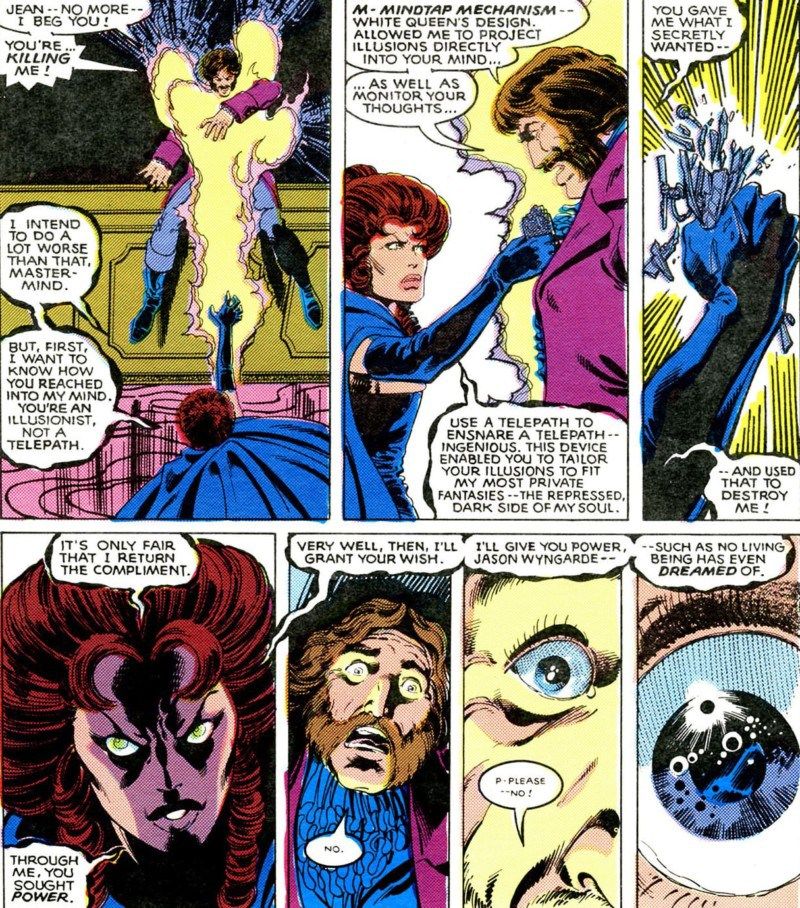
In the end, however, Mastermind represents the illusion of control in this story. He believes that his powers of illusion give him control of the situation through Jean. However, Wyngarde never has any real control except for what Jean chooses to give him, and when she regains that control from him, Mastermind is once more powerless, a small, wretched thing. In many ways, Mastermind is the prisoner of his own illusions, his own self-importance and lust for power, and his blindness to the fact that he“s dependent on the control of others to achieve anything. In the end, Jean finally sees through this illusion, reclaims her power, and creates a torment from his darkest desires, even if it comes at a horrible cost.
This introduces the final act of the Dark Phoenix Saga, where the X-Men must reach Jean and bring her back to the light. Dark Phoenix introduces herself in bold fashion by destroying the X-Men“s jet in midair, and then delivering the “fire and life incarnate”“ speech from the Dave Cockrum run. When used here, the context is far more frightening, since Dark Phoenix is no longer the woman they knew. It is no longer a statement of joy and new purpose, but a statement of rejection of all that Jean Grey was. Moreover, it is a rejection of Jean Grey“s humanity, with Dark Phoenix transcending into something greater and more immense than any of the X-Men. The X-Men are truly facing a goddess, one that has discarded her humanity and any love that held her to Earth. It“s a terrifying scene that results in one of the most heartbreaking battles in the team“s history; Dark Phoenix is too powerful and too dangerous to ignore, but the X-Men have no desire to hurt the one person they love most, especially Scott, Ororo, and Logan.
The X-Men fail to contain Dark Phoenix in their first battle. She is far too powerful for even the entire team to contain, and they are unable to emotionally reach Jean after how badly she“s been broken. However, Storm has a remarkable sense of Jean“s true emotional state: “She was like this when she saved the universe. But then, her power was tempered by joy and love. There is no joy””no love””in Dark Phoenix. I sense pain, great sadness, and an all-consuming lust.”“ Ororo, who loved Jean like a sister, would sense Jean“s feelings in a way few others would, and she is correct here. Dark Phoenix was created by betrayal and heartbreak. The joy inside her was broken when Mastermind lied to her, manipulated her into believing he loved her, and turned her into a tool for his own ambitions. Jean“s loss of control was sparked by the emotional break of that betrayal, and she lacked the control to restrain Dark Phoenix after her self-control was gone. To an extent, Dark Phoenix might even offer a comfort for Jean, a persona to disappear behind to protect herself from the pain. She“s a being of terrifying power, but she“s also a victim with complex desires, and Claremont never loses sight of these two aspects of Dark Phoenix.
Once the X-Men are defeated, Dark Phoenix leaves for the stars, and for some stories, this might be the ending. Instead, Claremont and Byrne up the scale to cosmic proportions, and it“s here where the story nearly gets away from them. Dark Phoenix arrives in the Shi“Ar Galaxy after using her power to open a stargate. She arrives near the Shi“Ar planet of D“Bari, where Jean arrives, ravenous and low on power after opening the stargate. This leads into the most horrible act Dark Phoenix commits, as she drains every iota of energy out of D“Bari“s sun, destroying every inhabited planet in the entire system. Claremont and Byrne draw the reader“s attention to the planet of the D“Bari “asparagus people”“ as they face their final moments at the hands of Dark Phoenix. This is not an act of malice, or hatred, or anything else on the part of Jean Grey. Dark Phoenix destroyed the entire system of D“Bari because she was hungry, and she put no thought whatsoever into the consequences of her actions. It is a monstrous scene, showing how powerful and how lost Dark Phoenix truly is, and also how insignificant most things are to a cosmic being like the Phoenix. Jean has transcended beyond human or mutant and even beyond the Marvel conception of godhood into the truly cosmic, but with no limits or restraints. It is an act one might ascribe to a being like Galactus, but committed by a lost young woman consumed by power and emotional damage.
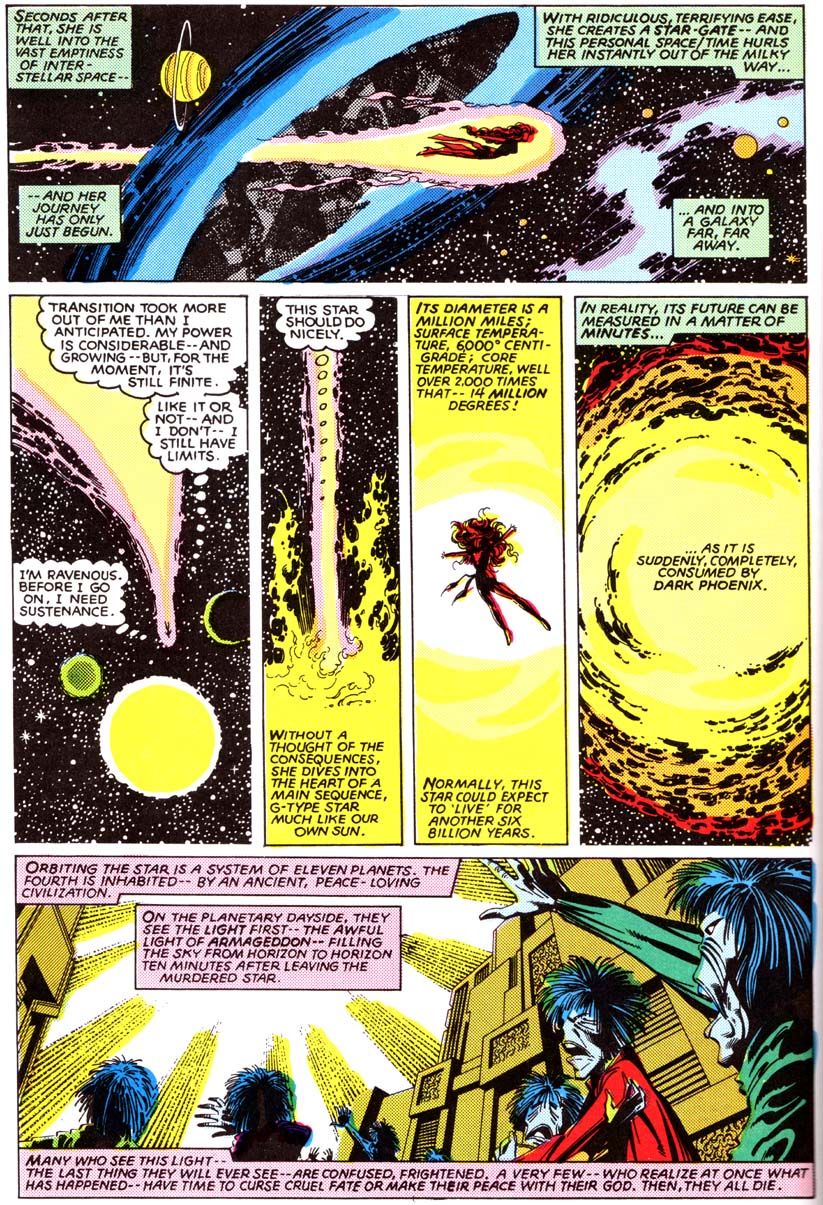
This was an act of such massive carnage that it did not go unnoticed by Marvel Editor-In-Chief Jim Shooter. Though Shooter was a controversial figure who made his share of mistakes as EIC, he always maintained high storytelling standards when it came to the comics he published. From a storytelling perspective, he believed that an act of planetary destruction like the death of D“Bari should come with narrative consequences. Shooter admitted in Phoenix: The Untold Story that while he was coming at it from a writer“s perspective and not a moralistic one, he did not believe that an act of this magnitude should come without consequences for Jean by the end. He had approved the destruction of D“Bari and thought it was excellent, but it needed an ending that accounted for a crime that terrible. Claremont and Byrne had other ideas, but Shooter had been very firm on his point. It was a point of contention that led to one of the most powerful endings in the history of Marvel Comics.
In fact, there were some consequences for Jean, as this ignited yet another painful personal battle within the X-Men family. In addition to destroying D“Bari, Dark Phoenix had also eliminated a Shi“Ar warship that had been sent to investigate. This earns the full personal attention of the Empress Lilandra, who is forced to order the destruction of Dark Phoenix. Even though Lilandra knows that Jean saved the universe, that her consort Charles Xavier loves Jean like a daughter, this crime is so massive that the Empire simply can“t overlook it. Lilandra is torn between her duty as Shi“Ar Empress and her love for Xavier, and it leads to a strain between Lilandra and the X-Men.
In the meantime, the X-Men have been preparing for a rematch with Dark Phoenix. They“ve been joined by the Beast, who was alerted to the Hellfire Club battle through an Avengers alert. Hank decides to cobble together a mnemonic scrambler, a head-mounted device that would limit Dark Phoenix“s power, though it would only be a temporary measure. Eventually Dark Phoenix does return to Earth, still torn and lost, hoping to return to Jean Grey“s home to find some answers. This leads to a dangerous encounter with Jean“s family, and another battle with the X-Men. The X-Men do somewhat better here, aided by the scrambler device and Scott“s battle tactics, but they“re still ultimately overwhelmed by the power of Dark Phoenix.
The tide is turned by the arrival of Charles Xavier, who takes advantage of Dark Phoenix“s weakened state to challenge her. Even this doesn“t guarantee Xavier a victory, and what he does gain is a very narrow one after a protracted mental battle. He is able to place mental blocks to restore Jean to her true personality, but it also restricts her power back to her normal pre-Phoenix levels. This is at best a temporary solution, but at least for a while, it seems like it works. Scott uses the opportunity to propose marriage, Jean accepts, and all seems to be right in the world again”¦ at least until the Shi“Ar teleports all the X-Men, including Jean, Beast, Angel, and Xavier, up to the Shi“Ar imperial flagship.
This leads to the final resolution of the Dark Phoenix Saga, and the immortal Uncanny X-Men #137. The initial setup to the issue is that Lilandra has come to judge Jean Grey for the crimes of destroying the planet D“Bari and the Shi“Ar warship. She“s also joined in this improvised tribunal by the Kree and the Skrulls, who are concerned about the fate of their own homeworlds should Dark Phoenix be unleashed on the universe again. Xavier uses his knowledge of the Shi“Ar legal system to challenge Lilandra to a duel of honor””the X-Men would fight the Shi“Ar Imperial Guard for the fate of Jean Grey. If the X-Men win, then Jean goes free, and if the Shi“Ar win, then Jean is to be taken away forever. It is a battle with ultimate stakes, even assuming that everyone survives the contest, and it is not a battle even the X-Men themselves are entirely comfortable with.
Claremont and Byrne spend quite a few pages leading up to the battle with some quieter character moments. Although they slow the pace of the issue, these are necessary character pieces that show how each of the X-Men is wrestling with the situation. Beast has some doubts, but he believes in the law, and he does not accept the judgment of the Shi“Ar. Logan accepts the difficulty of the odds against him, but he“s loyal to Jean until the end. These are individually short scenes, but they give us clear glimpses into the thoughts of the X-Men and their relationship with Jean and with their own values. It“s also a good moment to break tension and a good “calm before the storm”“ segment before the battle truly begins. Claremont is always a character-minded writer, and it“s always important to him to establish where they are emotionally. These scenes do an excellent job of that, and when the action finally hits, it becomes clear where the X-Men are operating from.
The battle between the X-Men and the Imperial Guard takes place on the Blue Area of the Moon, which has breathable atmosphere due to alien technology. The Blue Area would later be used by the Inhumans when they lived there, and it“s also an area associated with Uatu the Watcher and his base there. In fact, there“s an excellent scene in this issue where Logan stumbles on the Watcher“s base, before he is thrown out by Uatu for his own safety. The Blue Area is an interesting setting that“s been used for a number of stories, but this is easily the best remembered one.
Although the battles are best enjoyed as Claremont and Byrne laid them out, the result is that the contest generally does not go in the X-Men“s direction. Some of this is due to new Imperial Guard members like Warstar and Manta that the X-Men hadn“t previously fought. Some of this is due to outside interference, like Wolverine being taken out by the Kree and Skrull onlookers. And some of it is simply the X-Men being overwhelmed, though the battle between Colossus and Gladiator is truly epic and a sight to behold. It almost seems like all is lost and that the Imperial Guard may actually be able to win against the X-Men“s best efforts”¦ until Dark Phoenix rises once more.
With Phoenix reborn, the X-Men turn their attention to stopping Jean. This time, Jean doesn“t stop them, and in fact, she begs her friends to kill her. Jean knows how much death she“s responsible for, and she knows she is barely holding on to her sanity and control. She loves Scott, but she also refuses to be part of more death and destruction. She knows there is a risk that if her control slips, even for an instant, that she may cause another planetary extinction event like she did on D“Bari, or possibly even more cataclysmic than that. Jean is full of grief and guilt and pain, but she also has rediscovered her capacity to love, and reconnecting to Scott gives her a new strength that she never had before. But she knows that Scott would never let her do the one thing she must do to save the universe. The X-Men will always try to save her first, because they love her, but Jean knows it won“t be enough.
Jean has one last conversation with Scott on the moon, and it is a touching goodbye speech. She is doing what she must do for the sake of others, because she loves Scott and the X-Men. She will not accept another death on her conscience that isn“t her own. Jean is choosing to die for the sake of the universe, but she hasn“t lost sight of what truly matters to her. “I love you, Scott,”“ she says. “A part of me will always be with you.”“ As much as she loves Scott, she would rather let him go than become something she abhors. It is a powerful parting moment for one of the greatest couples in Marvel history, a pair that we“ve followed for several years during their ups and downs.
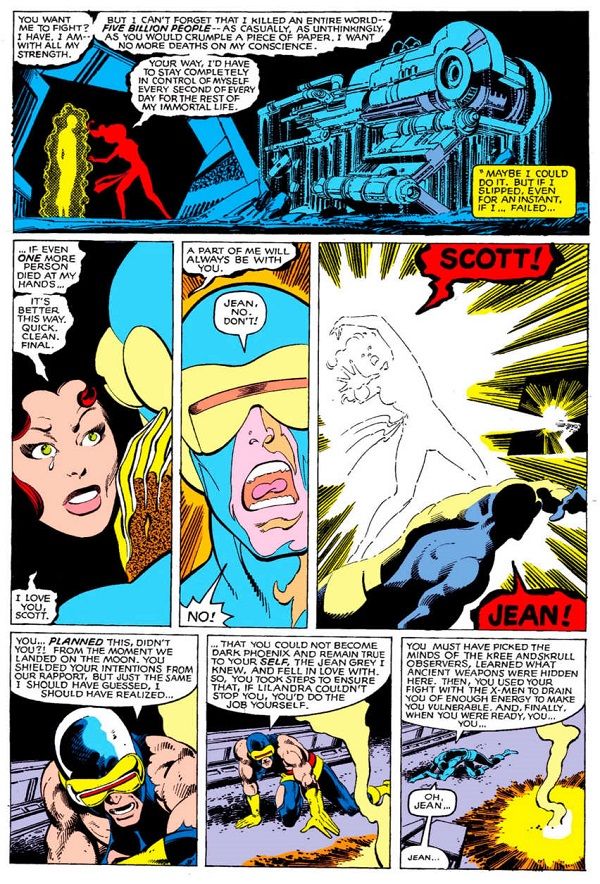
And then Jean is gone, vaporized to nothing as an energy blast strikes her from behind. Jean had planned it this way. She knew what was there from picking the minds of the alien observers, and how to use her telekinesis to make the alien devices of the Blue Area work. If Jean couldn“t be saved, she would die before becoming Dark Phoenix again. It is a beautiful tragic ending, as much as the story roots for Jean to be saved, the stakes are so large that she could never come back from them. It“s a death that had real power because it was earned, because the series made the reader care about these characters and in building up the tragedy until it hit the epic cosmic scale. This was the ending the Dark Phoenix Saga needed”¦ and it very nearly didn“t happen.
Claremont and Byrne originally had a much different idea in mind. The original idea was that Jean would be depowered by the Shi“Ar, as depicted in Phoenix: The Untold Story, and she and Scott would retire and live peacefully for a time. There was even a beautiful and idyllic splash page of Jean and Scott that had been scheduled for the following issue. As far as Claremont knew, the original ending had been approved; according to him, he had been told (apparently by then-editor Jim Salicrup) that the story had been fully approved.
That turned out not to be the case, because Jim Shooter had found out about this development fairly late in the process and insisted on a change before the issue went out to print. This led to creative disagreements between Claremont and Byrne with Shooter on the direction of the Dark Phoenix Saga. Shooter wanted an ending that offered real consequences for Jean“s actions as Dark Phoenix, but Claremont didn“t want his long-term plans derailed by the X-Men constantly trying to save Jean from the Shi“Ar. The decision to kill Jean at the end was allegedly a not-so-serious threat at first from Claremont and Byrne, but it became serious when it was clear that there wasn“t a better way to end Jean“s story. In the end, the heroic sacrifice was the best ending for Jean Grey, an ending that was resolved on Jean“s own terms and that resolved the core problem. This was an ending that represents the best and worst of the editorial process, the unexpected surprises and the powerful work that results from creatives and editorial working together to resolve a story.
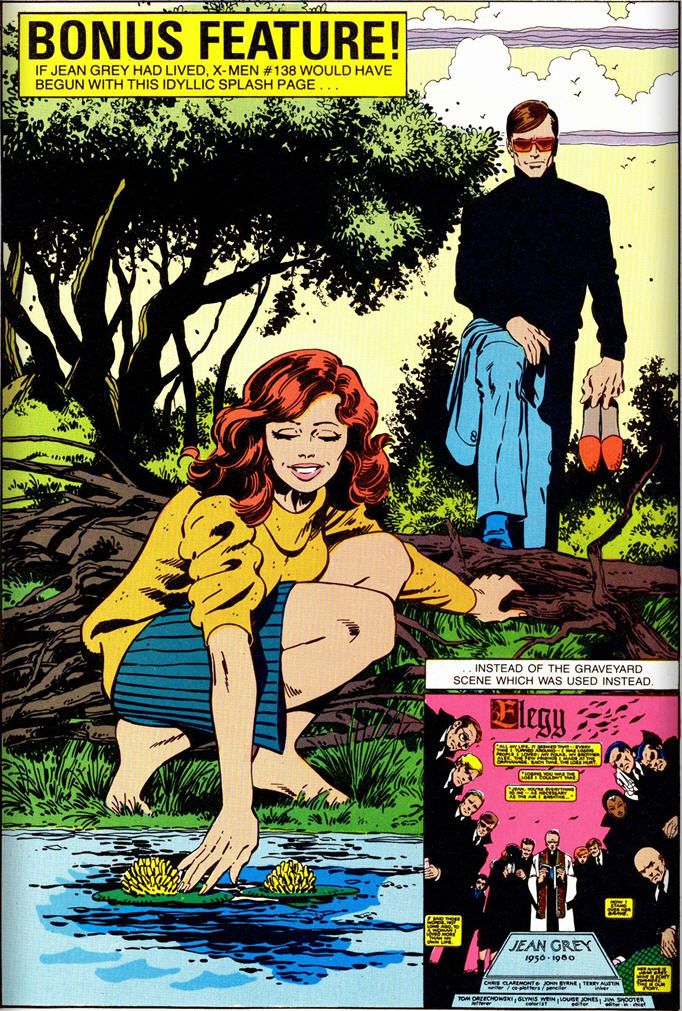
The Dark Phoenix Saga has been attempted on screen numerous times, but with only one real success. The version shown on X-Men: The Animated Series remains the best of these, mainly because it understands how the comic works as a long three-act structure and doesn“t sacrifice any of its heart for screen time. The emotional core is there, the love between Scott and Jean, and the gradual change as Jean rises and falls as a character. The large-screen versions either made too many cuts (such as Disney“s decision to truncate Dark Phoenix from two films to one) or completely misunderstood the story and its emotional core. This is one of the most difficult comic book stories to adapt, and it is perhaps for the best that Hollywood leaves Jean in her grave unless they can give this story the time, care, and attention that it deserves.
Next time, we“ll look at the aftermath of Jean Grey“s death, and towards the end of the most epic creative partnership in the history of the X-Men.
Author Profile
- Steve Sellers had been a fan of superheroes ever since Superman: The Movie. But it took the JSA, the Legion of Super-Heroes, Dragonlance, Lord of the Rings, Twilight Zone, and Chris Claremont's legendary run on the X-Men to make him a writer and a longtime fan of comics, fantasy, and science fiction. Steve is the co-creator of WHITE DRUID & MICHAEL NERO and GUARDIANS OF ELAYIM for Omen Comics, and he is also the creator of BLITZ and SHOCKWAVE for Revelation Comics (an imprint of Omen Comics).






